An Analysis of the Roles and Responsibilities of a BIM Manager
VerifiedAdded on 2023/06/07
|7
|1555
|383
Report
AI Summary
This report delves into the crucial roles and responsibilities of a BIM Manager within the construction industry. It highlights the importance of BIM (Building Information Modeling) in modern construction, emphasizing its ability to overcome challenges such as design delays, cost overruns, and poor project delivery. The report outlines how BIM managers coordinate various activities, including model creation, training, and communication among stakeholders like architects, engineers, contractors, and facility managers. Key responsibilities include ensuring adherence to building codes, facilitating information exchange, coordinating design changes, and managing the 3D manufacturing model. The report stresses the need for BIM managers to possess a strong understanding of the building industry, often requiring experience as an architect or engineer. It concludes by advocating for a greater appreciation of BIM managers and the adoption of different levels of BIM management to improve project delivery, reduce costs, and minimize delays.
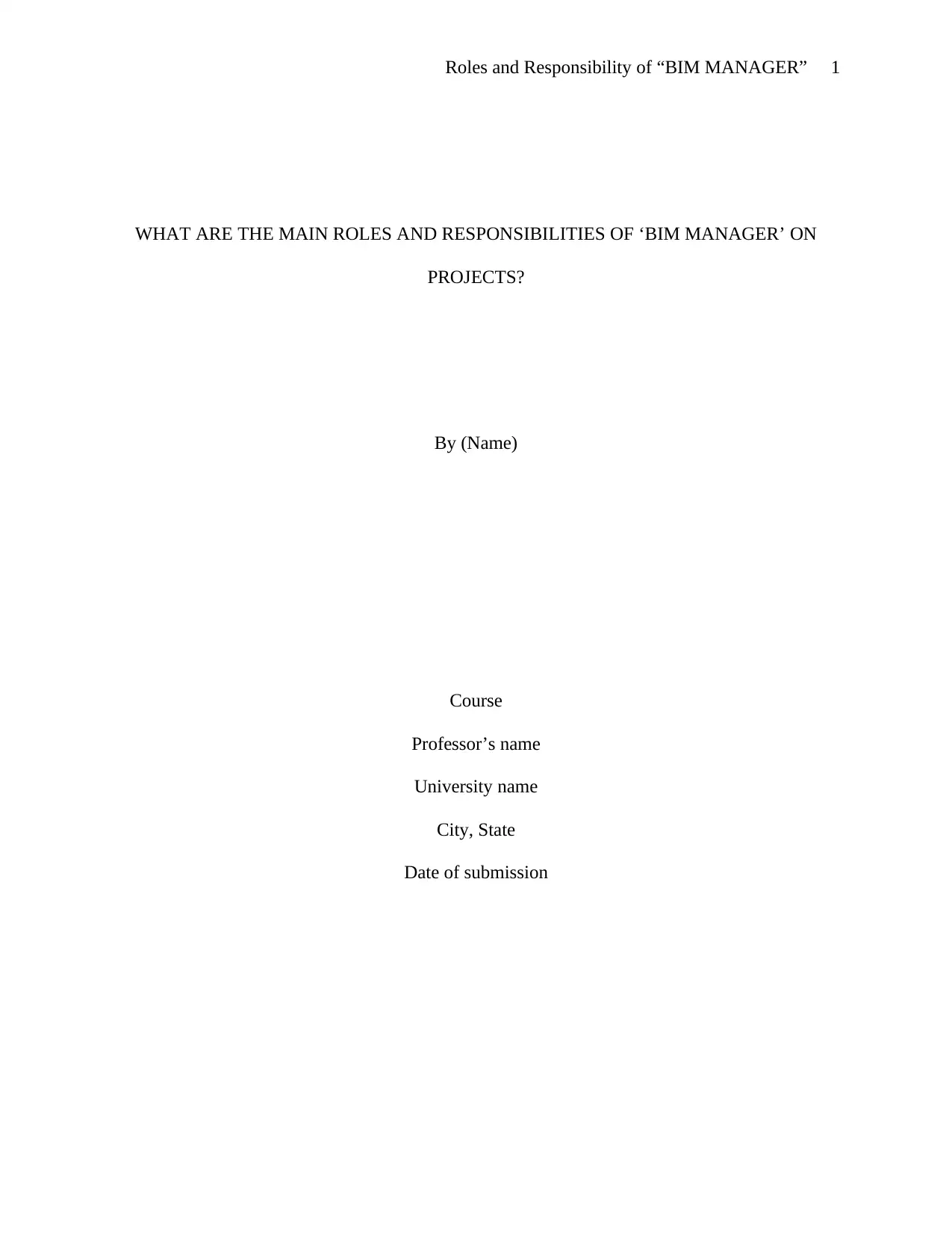
Roles and Responsibility of “BIM MANAGER” 1
WHAT ARE THE MAIN ROLES AND RESPONSIBILITIES OF ‘BIM MANAGER’ ON
PROJECTS?
By (Name)
Course
Professor’s name
University name
City, State
Date of submission
WHAT ARE THE MAIN ROLES AND RESPONSIBILITIES OF ‘BIM MANAGER’ ON
PROJECTS?
By (Name)
Course
Professor’s name
University name
City, State
Date of submission
Paraphrase This Document
Need a fresh take? Get an instant paraphrase of this document with our AI Paraphraser
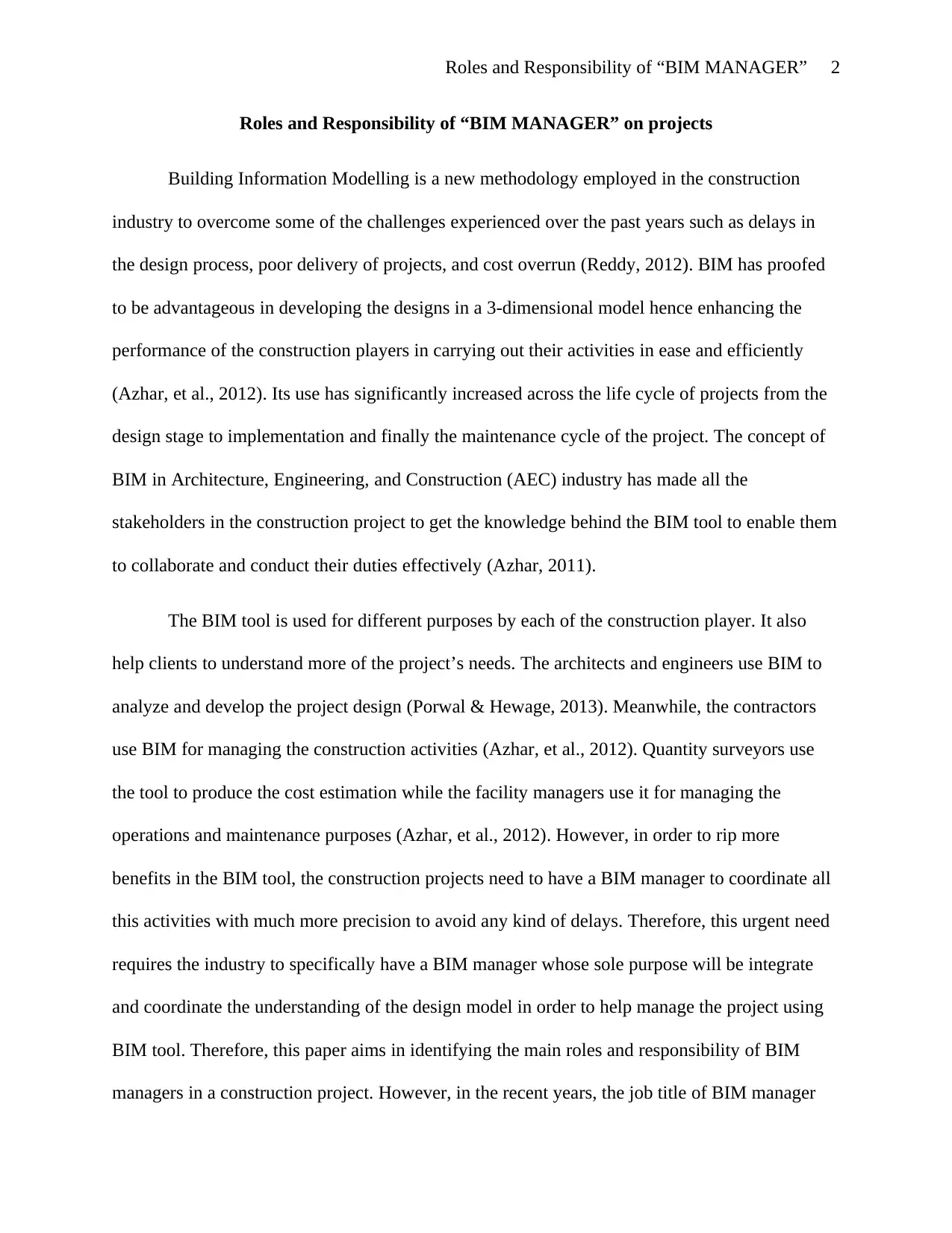
Roles and Responsibility of “BIM MANAGER” 2
Roles and Responsibility of “BIM MANAGER” on projects
Building Information Modelling is a new methodology employed in the construction
industry to overcome some of the challenges experienced over the past years such as delays in
the design process, poor delivery of projects, and cost overrun (Reddy, 2012). BIM has proofed
to be advantageous in developing the designs in a 3-dimensional model hence enhancing the
performance of the construction players in carrying out their activities in ease and efficiently
(Azhar, et al., 2012). Its use has significantly increased across the life cycle of projects from the
design stage to implementation and finally the maintenance cycle of the project. The concept of
BIM in Architecture, Engineering, and Construction (AEC) industry has made all the
stakeholders in the construction project to get the knowledge behind the BIM tool to enable them
to collaborate and conduct their duties effectively (Azhar, 2011).
The BIM tool is used for different purposes by each of the construction player. It also
help clients to understand more of the project’s needs. The architects and engineers use BIM to
analyze and develop the project design (Porwal & Hewage, 2013). Meanwhile, the contractors
use BIM for managing the construction activities (Azhar, et al., 2012). Quantity surveyors use
the tool to produce the cost estimation while the facility managers use it for managing the
operations and maintenance purposes (Azhar, et al., 2012). However, in order to rip more
benefits in the BIM tool, the construction projects need to have a BIM manager to coordinate all
this activities with much more precision to avoid any kind of delays. Therefore, this urgent need
requires the industry to specifically have a BIM manager whose sole purpose will be integrate
and coordinate the understanding of the design model in order to help manage the project using
BIM tool. Therefore, this paper aims in identifying the main roles and responsibility of BIM
managers in a construction project. However, in the recent years, the job title of BIM manager
Roles and Responsibility of “BIM MANAGER” on projects
Building Information Modelling is a new methodology employed in the construction
industry to overcome some of the challenges experienced over the past years such as delays in
the design process, poor delivery of projects, and cost overrun (Reddy, 2012). BIM has proofed
to be advantageous in developing the designs in a 3-dimensional model hence enhancing the
performance of the construction players in carrying out their activities in ease and efficiently
(Azhar, et al., 2012). Its use has significantly increased across the life cycle of projects from the
design stage to implementation and finally the maintenance cycle of the project. The concept of
BIM in Architecture, Engineering, and Construction (AEC) industry has made all the
stakeholders in the construction project to get the knowledge behind the BIM tool to enable them
to collaborate and conduct their duties effectively (Azhar, 2011).
The BIM tool is used for different purposes by each of the construction player. It also
help clients to understand more of the project’s needs. The architects and engineers use BIM to
analyze and develop the project design (Porwal & Hewage, 2013). Meanwhile, the contractors
use BIM for managing the construction activities (Azhar, et al., 2012). Quantity surveyors use
the tool to produce the cost estimation while the facility managers use it for managing the
operations and maintenance purposes (Azhar, et al., 2012). However, in order to rip more
benefits in the BIM tool, the construction projects need to have a BIM manager to coordinate all
this activities with much more precision to avoid any kind of delays. Therefore, this urgent need
requires the industry to specifically have a BIM manager whose sole purpose will be integrate
and coordinate the understanding of the design model in order to help manage the project using
BIM tool. Therefore, this paper aims in identifying the main roles and responsibility of BIM
managers in a construction project. However, in the recent years, the job title of BIM manager
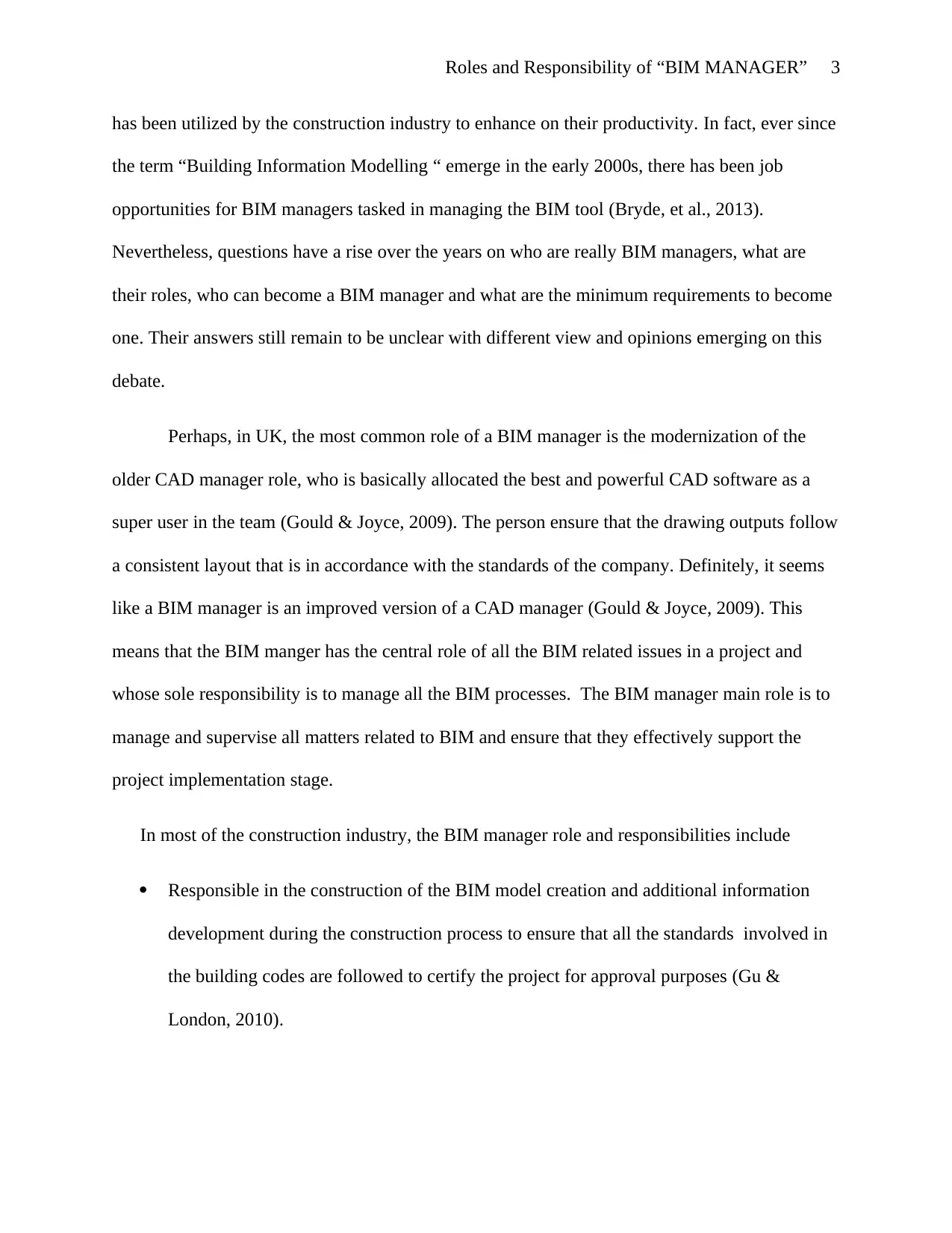
Roles and Responsibility of “BIM MANAGER” 3
has been utilized by the construction industry to enhance on their productivity. In fact, ever since
the term “Building Information Modelling “ emerge in the early 2000s, there has been job
opportunities for BIM managers tasked in managing the BIM tool (Bryde, et al., 2013).
Nevertheless, questions have a rise over the years on who are really BIM managers, what are
their roles, who can become a BIM manager and what are the minimum requirements to become
one. Their answers still remain to be unclear with different view and opinions emerging on this
debate.
Perhaps, in UK, the most common role of a BIM manager is the modernization of the
older CAD manager role, who is basically allocated the best and powerful CAD software as a
super user in the team (Gould & Joyce, 2009). The person ensure that the drawing outputs follow
a consistent layout that is in accordance with the standards of the company. Definitely, it seems
like a BIM manager is an improved version of a CAD manager (Gould & Joyce, 2009). This
means that the BIM manger has the central role of all the BIM related issues in a project and
whose sole responsibility is to manage all the BIM processes. The BIM manager main role is to
manage and supervise all matters related to BIM and ensure that they effectively support the
project implementation stage.
In most of the construction industry, the BIM manager role and responsibilities include
Responsible in the construction of the BIM model creation and additional information
development during the construction process to ensure that all the standards involved in
the building codes are followed to certify the project for approval purposes (Gu &
London, 2010).
has been utilized by the construction industry to enhance on their productivity. In fact, ever since
the term “Building Information Modelling “ emerge in the early 2000s, there has been job
opportunities for BIM managers tasked in managing the BIM tool (Bryde, et al., 2013).
Nevertheless, questions have a rise over the years on who are really BIM managers, what are
their roles, who can become a BIM manager and what are the minimum requirements to become
one. Their answers still remain to be unclear with different view and opinions emerging on this
debate.
Perhaps, in UK, the most common role of a BIM manager is the modernization of the
older CAD manager role, who is basically allocated the best and powerful CAD software as a
super user in the team (Gould & Joyce, 2009). The person ensure that the drawing outputs follow
a consistent layout that is in accordance with the standards of the company. Definitely, it seems
like a BIM manager is an improved version of a CAD manager (Gould & Joyce, 2009). This
means that the BIM manger has the central role of all the BIM related issues in a project and
whose sole responsibility is to manage all the BIM processes. The BIM manager main role is to
manage and supervise all matters related to BIM and ensure that they effectively support the
project implementation stage.
In most of the construction industry, the BIM manager role and responsibilities include
Responsible in the construction of the BIM model creation and additional information
development during the construction process to ensure that all the standards involved in
the building codes are followed to certify the project for approval purposes (Gu &
London, 2010).
⊘ This is a preview!⊘
Do you want full access?
Subscribe today to unlock all pages.

Trusted by 1+ million students worldwide
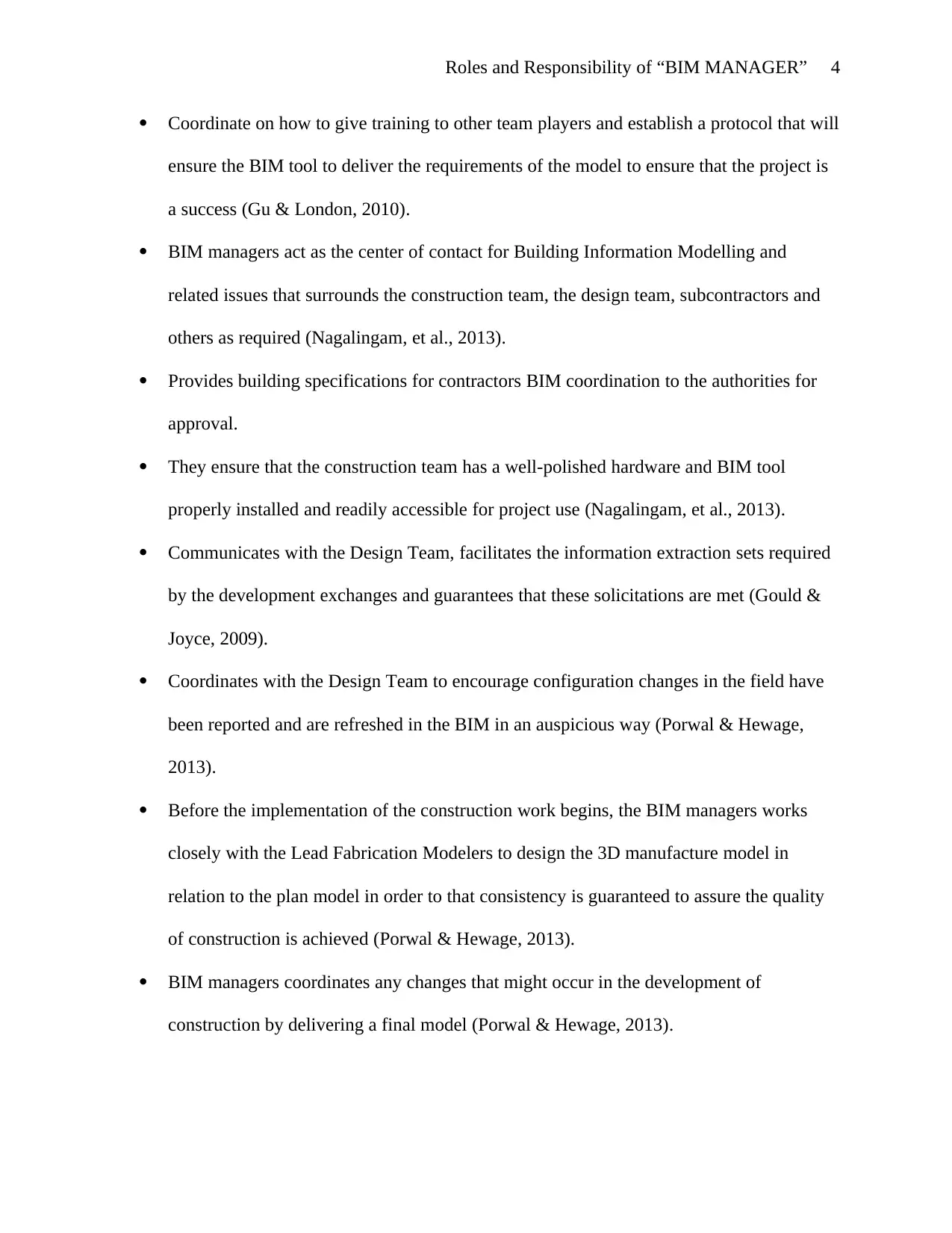
Roles and Responsibility of “BIM MANAGER” 4
Coordinate on how to give training to other team players and establish a protocol that will
ensure the BIM tool to deliver the requirements of the model to ensure that the project is
a success (Gu & London, 2010).
BIM managers act as the center of contact for Building Information Modelling and
related issues that surrounds the construction team, the design team, subcontractors and
others as required (Nagalingam, et al., 2013).
Provides building specifications for contractors BIM coordination to the authorities for
approval.
They ensure that the construction team has a well-polished hardware and BIM tool
properly installed and readily accessible for project use (Nagalingam, et al., 2013).
Communicates with the Design Team, facilitates the information extraction sets required
by the development exchanges and guarantees that these solicitations are met (Gould &
Joyce, 2009).
Coordinates with the Design Team to encourage configuration changes in the field have
been reported and are refreshed in the BIM in an auspicious way (Porwal & Hewage,
2013).
Before the implementation of the construction work begins, the BIM managers works
closely with the Lead Fabrication Modelers to design the 3D manufacture model in
relation to the plan model in order to that consistency is guaranteed to assure the quality
of construction is achieved (Porwal & Hewage, 2013).
BIM managers coordinates any changes that might occur in the development of
construction by delivering a final model (Porwal & Hewage, 2013).
Coordinate on how to give training to other team players and establish a protocol that will
ensure the BIM tool to deliver the requirements of the model to ensure that the project is
a success (Gu & London, 2010).
BIM managers act as the center of contact for Building Information Modelling and
related issues that surrounds the construction team, the design team, subcontractors and
others as required (Nagalingam, et al., 2013).
Provides building specifications for contractors BIM coordination to the authorities for
approval.
They ensure that the construction team has a well-polished hardware and BIM tool
properly installed and readily accessible for project use (Nagalingam, et al., 2013).
Communicates with the Design Team, facilitates the information extraction sets required
by the development exchanges and guarantees that these solicitations are met (Gould &
Joyce, 2009).
Coordinates with the Design Team to encourage configuration changes in the field have
been reported and are refreshed in the BIM in an auspicious way (Porwal & Hewage,
2013).
Before the implementation of the construction work begins, the BIM managers works
closely with the Lead Fabrication Modelers to design the 3D manufacture model in
relation to the plan model in order to that consistency is guaranteed to assure the quality
of construction is achieved (Porwal & Hewage, 2013).
BIM managers coordinates any changes that might occur in the development of
construction by delivering a final model (Porwal & Hewage, 2013).
Paraphrase This Document
Need a fresh take? Get an instant paraphrase of this document with our AI Paraphraser
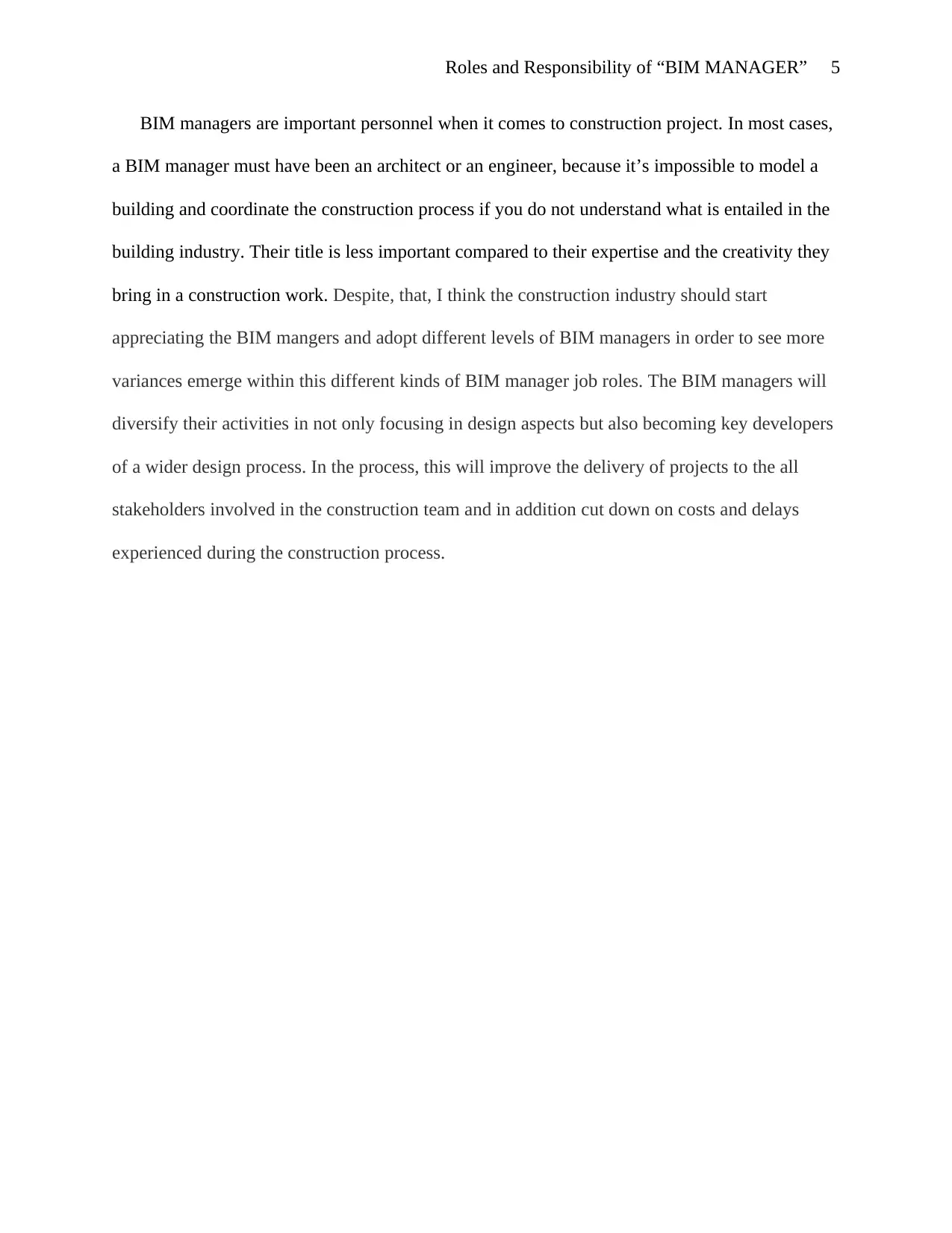
Roles and Responsibility of “BIM MANAGER” 5
BIM managers are important personnel when it comes to construction project. In most cases,
a BIM manager must have been an architect or an engineer, because it’s impossible to model a
building and coordinate the construction process if you do not understand what is entailed in the
building industry. Their title is less important compared to their expertise and the creativity they
bring in a construction work. Despite, that, I think the construction industry should start
appreciating the BIM mangers and adopt different levels of BIM managers in order to see more
variances emerge within this different kinds of BIM manager job roles. The BIM managers will
diversify their activities in not only focusing in design aspects but also becoming key developers
of a wider design process. In the process, this will improve the delivery of projects to the all
stakeholders involved in the construction team and in addition cut down on costs and delays
experienced during the construction process.
BIM managers are important personnel when it comes to construction project. In most cases,
a BIM manager must have been an architect or an engineer, because it’s impossible to model a
building and coordinate the construction process if you do not understand what is entailed in the
building industry. Their title is less important compared to their expertise and the creativity they
bring in a construction work. Despite, that, I think the construction industry should start
appreciating the BIM mangers and adopt different levels of BIM managers in order to see more
variances emerge within this different kinds of BIM manager job roles. The BIM managers will
diversify their activities in not only focusing in design aspects but also becoming key developers
of a wider design process. In the process, this will improve the delivery of projects to the all
stakeholders involved in the construction team and in addition cut down on costs and delays
experienced during the construction process.
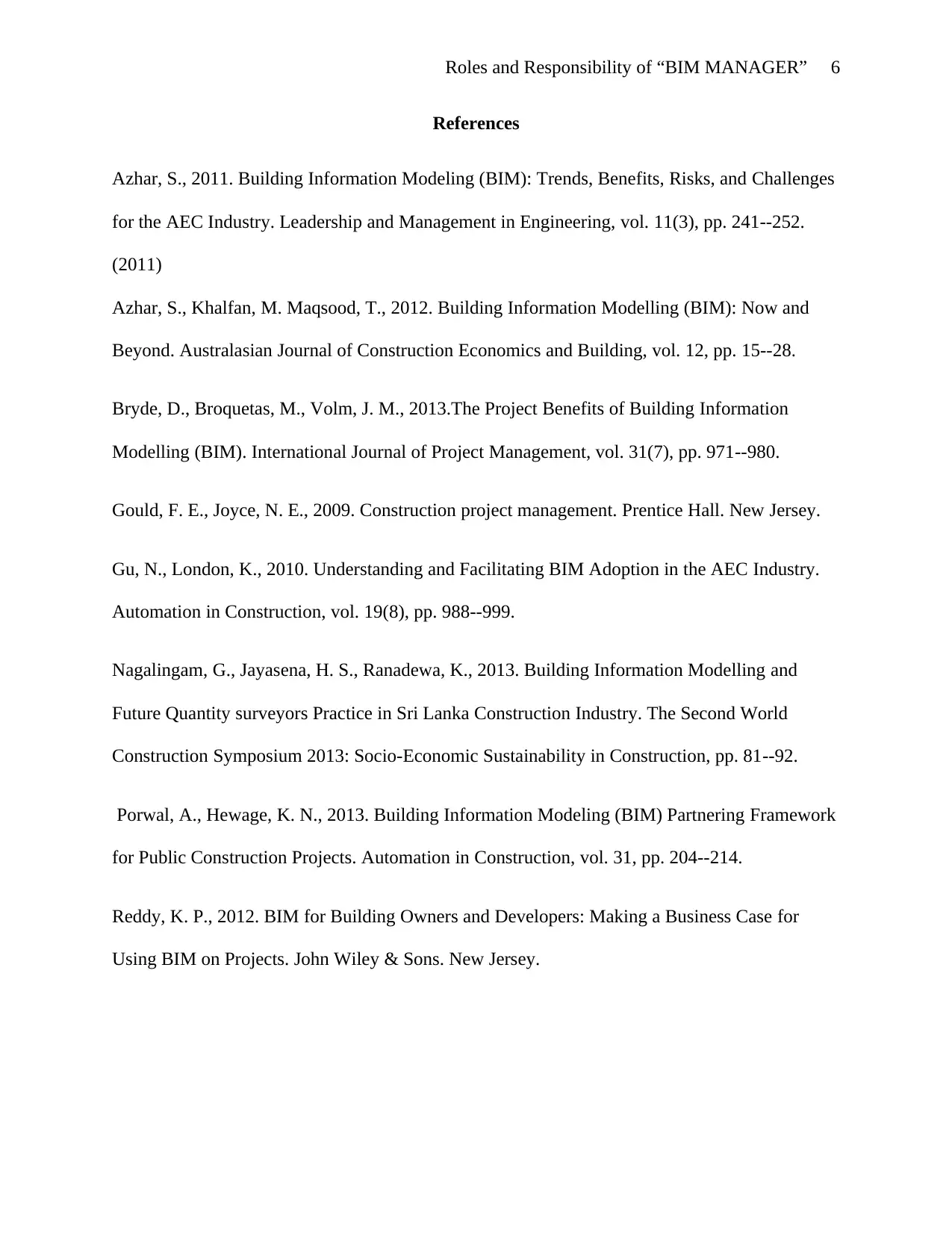
Roles and Responsibility of “BIM MANAGER” 6
References
Azhar, S., 2011. Building Information Modeling (BIM): Trends, Benefits, Risks, and Challenges
for the AEC Industry. Leadership and Management in Engineering, vol. 11(3), pp. 241--252.
(2011)
Azhar, S., Khalfan, M. Maqsood, T., 2012. Building Information Modelling (BIM): Now and
Beyond. Australasian Journal of Construction Economics and Building, vol. 12, pp. 15--28.
Bryde, D., Broquetas, M., Volm, J. M., 2013.The Project Benefits of Building Information
Modelling (BIM). International Journal of Project Management, vol. 31(7), pp. 971--980.
Gould, F. E., Joyce, N. E., 2009. Construction project management. Prentice Hall. New Jersey.
Gu, N., London, K., 2010. Understanding and Facilitating BIM Adoption in the AEC Industry.
Automation in Construction, vol. 19(8), pp. 988--999.
Nagalingam, G., Jayasena, H. S., Ranadewa, K., 2013. Building Information Modelling and
Future Quantity surveyors Practice in Sri Lanka Construction Industry. The Second World
Construction Symposium 2013: Socio-Economic Sustainability in Construction, pp. 81--92.
Porwal, A., Hewage, K. N., 2013. Building Information Modeling (BIM) Partnering Framework
for Public Construction Projects. Automation in Construction, vol. 31, pp. 204--214.
Reddy, K. P., 2012. BIM for Building Owners and Developers: Making a Business Case for
Using BIM on Projects. John Wiley & Sons. New Jersey.
References
Azhar, S., 2011. Building Information Modeling (BIM): Trends, Benefits, Risks, and Challenges
for the AEC Industry. Leadership and Management in Engineering, vol. 11(3), pp. 241--252.
(2011)
Azhar, S., Khalfan, M. Maqsood, T., 2012. Building Information Modelling (BIM): Now and
Beyond. Australasian Journal of Construction Economics and Building, vol. 12, pp. 15--28.
Bryde, D., Broquetas, M., Volm, J. M., 2013.The Project Benefits of Building Information
Modelling (BIM). International Journal of Project Management, vol. 31(7), pp. 971--980.
Gould, F. E., Joyce, N. E., 2009. Construction project management. Prentice Hall. New Jersey.
Gu, N., London, K., 2010. Understanding and Facilitating BIM Adoption in the AEC Industry.
Automation in Construction, vol. 19(8), pp. 988--999.
Nagalingam, G., Jayasena, H. S., Ranadewa, K., 2013. Building Information Modelling and
Future Quantity surveyors Practice in Sri Lanka Construction Industry. The Second World
Construction Symposium 2013: Socio-Economic Sustainability in Construction, pp. 81--92.
Porwal, A., Hewage, K. N., 2013. Building Information Modeling (BIM) Partnering Framework
for Public Construction Projects. Automation in Construction, vol. 31, pp. 204--214.
Reddy, K. P., 2012. BIM for Building Owners and Developers: Making a Business Case for
Using BIM on Projects. John Wiley & Sons. New Jersey.
⊘ This is a preview!⊘
Do you want full access?
Subscribe today to unlock all pages.

Trusted by 1+ million students worldwide

Roles and Responsibility of “BIM MANAGER” 7
1 out of 7
Related Documents
Your All-in-One AI-Powered Toolkit for Academic Success.
+13062052269
info@desklib.com
Available 24*7 on WhatsApp / Email
![[object Object]](/_next/static/media/star-bottom.7253800d.svg)
Unlock your academic potential
Copyright © 2020–2025 A2Z Services. All Rights Reserved. Developed and managed by ZUCOL.




